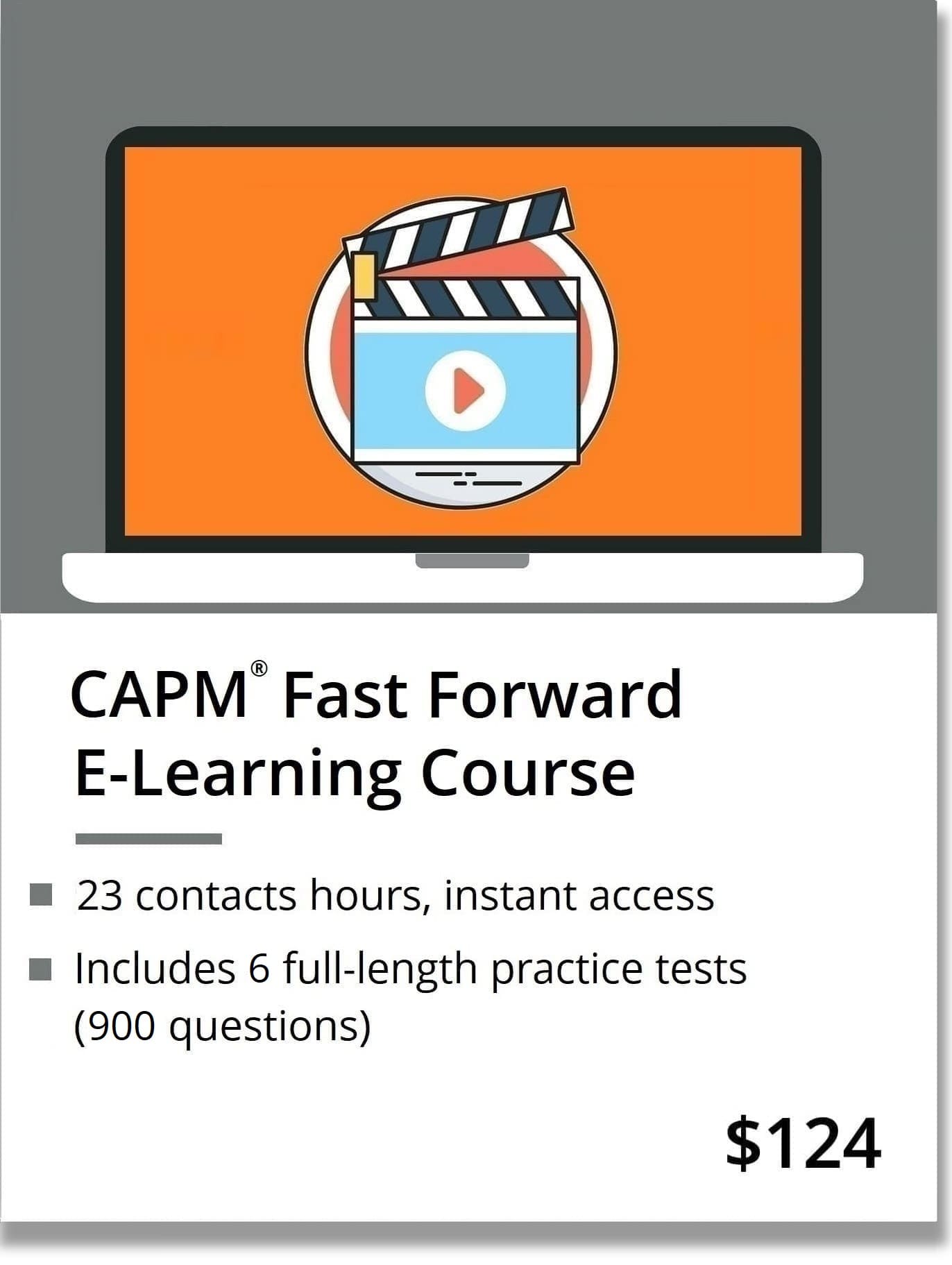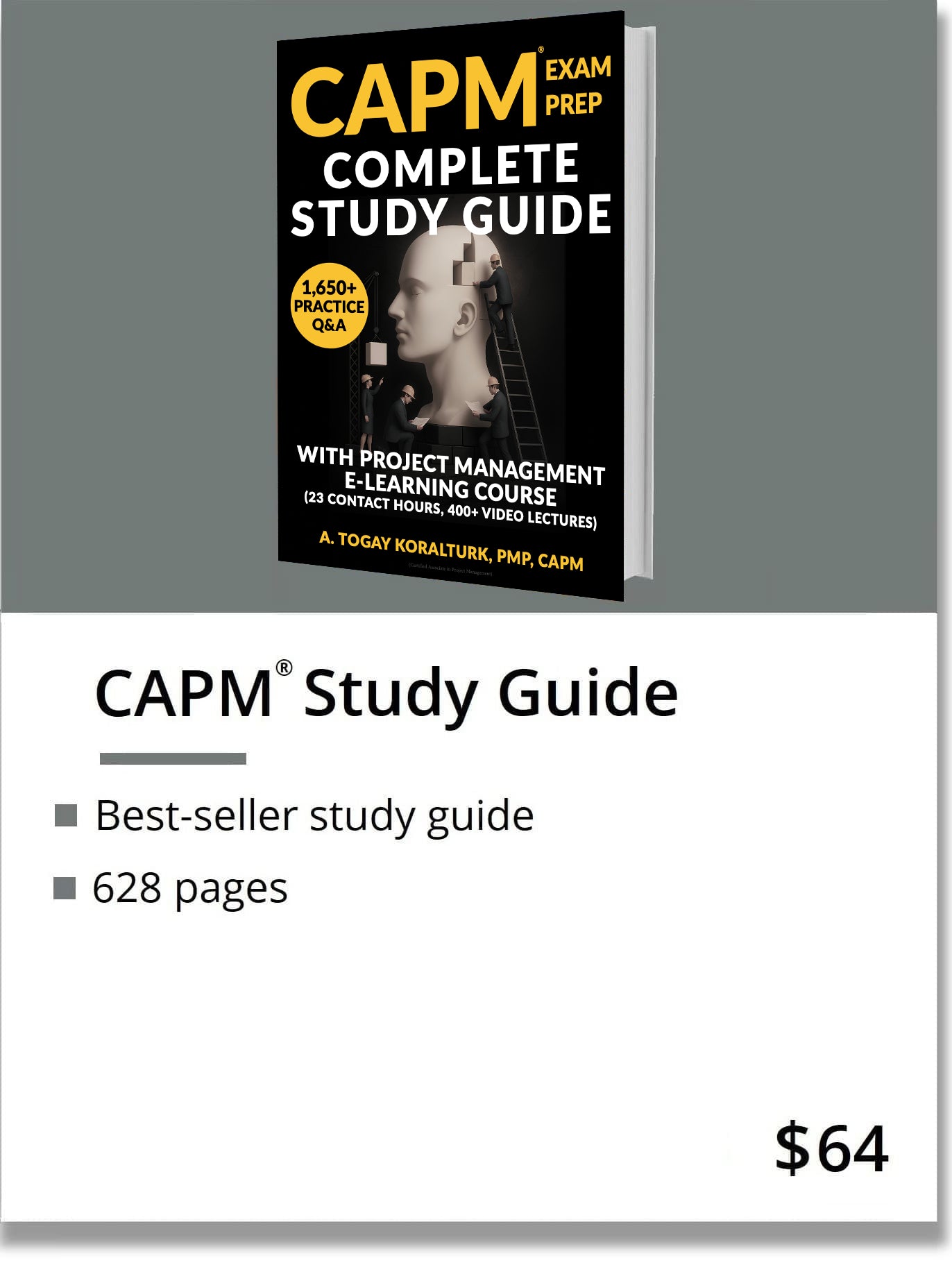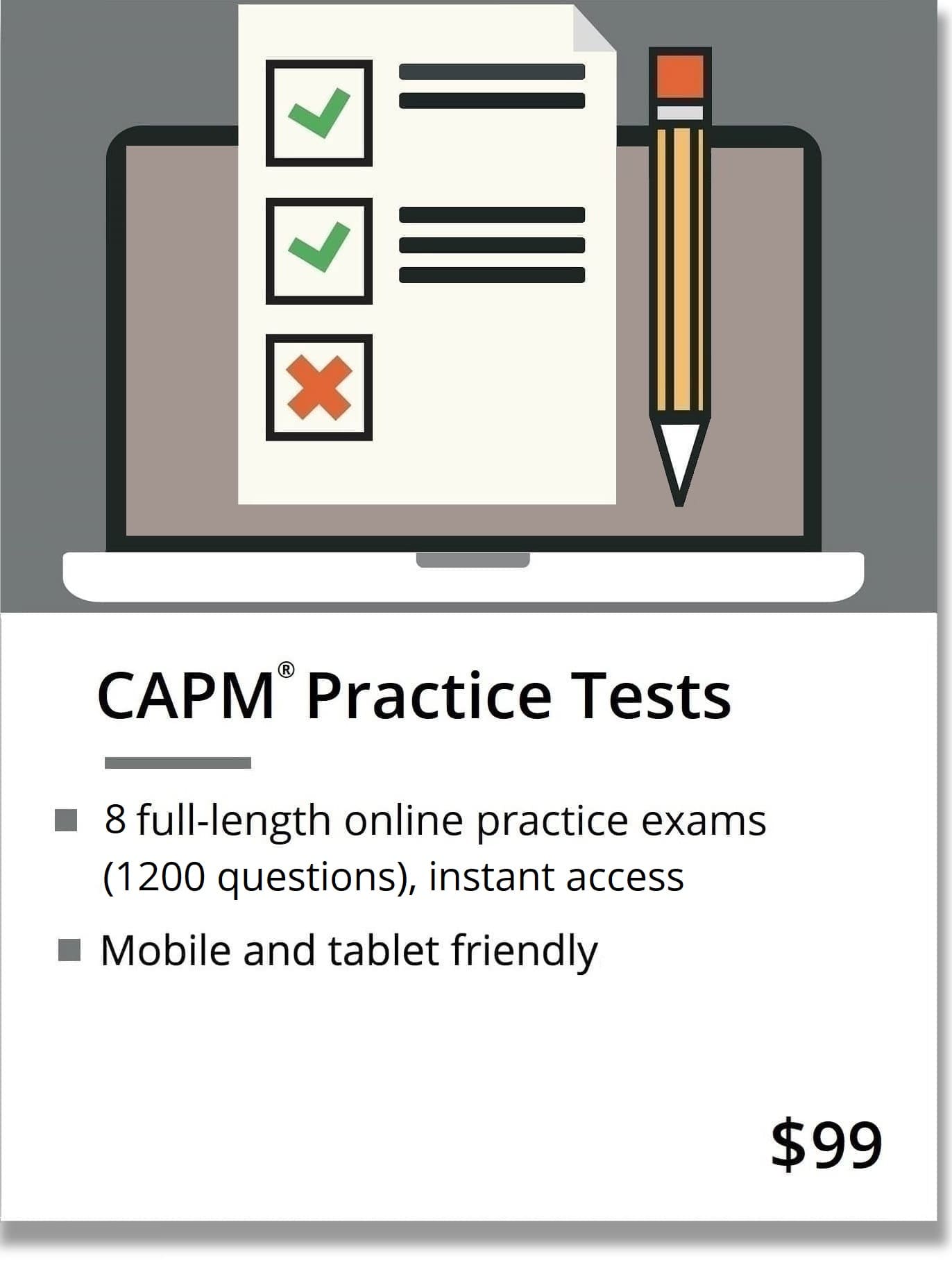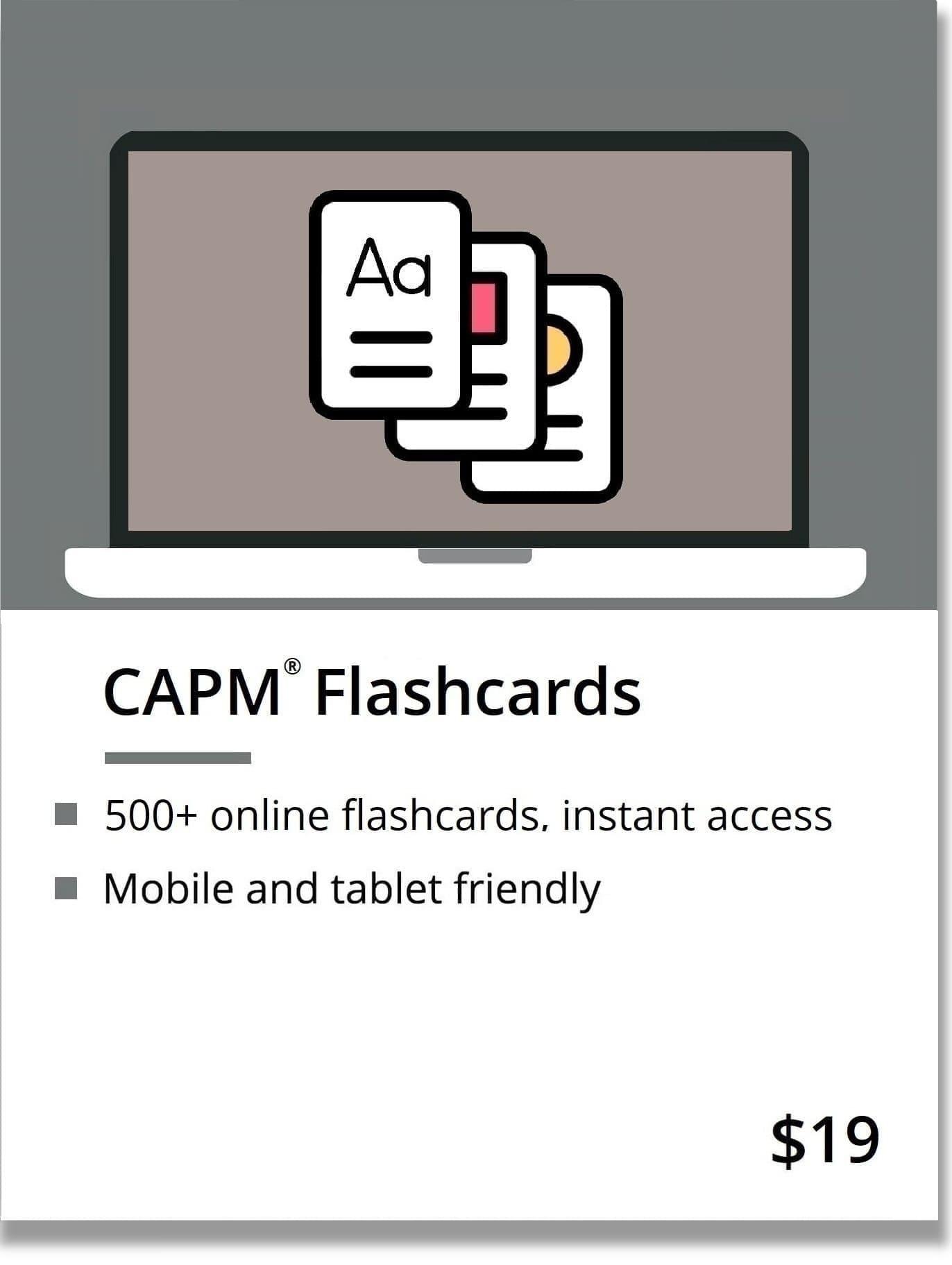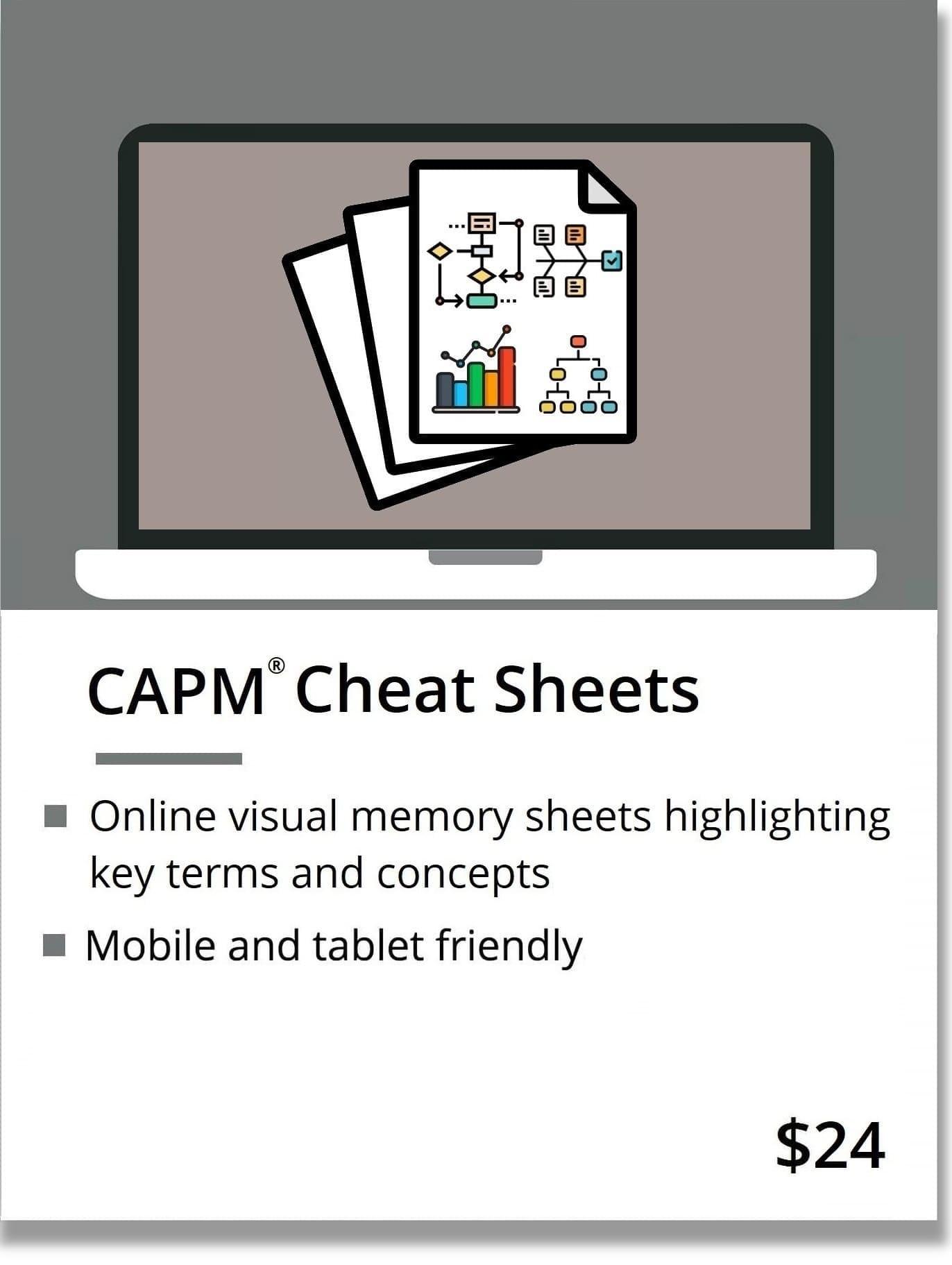
CAPM® Exam Prep: Complete Study Guide Audiobook
-
Transform your Certified Associate in Project Management (CAPM) exam preparation with the audiobook edition of the CAPM Exam Prep: Complete Study Guide. Perfect for on-the-go learning, this audiobook makes it simple to study whenever and wherever you need.
Features:
- Engaging and easy-to-follow audio format.
- Professionally narrated 21+hour audiobook.
- Instant access.
-
A. Togay Koralturk is a globally recognized pioneer and educator in project management and sustainable design and construction, an accomplished author and entrepreneur. His first publication, the LEED Complete Study Guide series, quickly made him a best-selling author by reaching tens of thousands of professionals and has been extensively adopted as primary course material for bachelor's and master's degree classes in architecture and civil engineering in universities throughout the United States. In his most recent venture, he introduced the game-changing PMP Complete Study Guide series.
Holding a bachelor's degree in civil engineering, and a master's in construction management from the University of Southern California, he has played a pivotal role in leading many construction projects ranging from 100 million dollars to 500 million dollars worldwide, and he has educated thousands of professionals. He began his project management career in Los Angeles, California and earned his LEED AP credential in 2008 and PMP certification along the way. Continuing his professional journey, he founded Projectific Inc. and Projeric LLC, where he serves as the CEO, steering PMP and LEED exam preparation services and other innovative educational projects.
-
ISBN-10: 1965085040 (audiobook)
ISBN-13: 978-1965085042 (audiobook)
Total playtime: 21+ hours
Publisher: Projeric
-
01:29 Chapter 1: Introduction
Chapter 1: Introduction
05:43 What Makes This Book Different
What Makes This Book Different
01:45 CAPM Exam Structure
CAPM Exam Structure
17:32 What are CAPM Exam Questions Like?
What are CAPM Exam Questions Like?
00:41 An Overview of CAPM Exam Policies and Procedures
An Overview of CAPM Exam Policies and Procedures
00:35 Eligibility Requirements to Take the CAPM Exam
Eligibility Requirements to Take the CAPM Exam
00:55 Exam Fees
Exam Fees
00:59 Where to Take the Exam?
Where to Take the Exam?
01:47 How to Apply for the Exam?
How to Apply for the Exam?
00:43 PMI® Audits
PMI® Audits
-
02:03 Chapter 2: Introduction
Chapter 2: Introduction
10:37 What is a Project?
What is a Project?
03:22 Projects and Operations
Projects and Operations
05:39 The Ultimate Project Goal: Creating Value
The Ultimate Project Goal: Creating Value
03:05 What is Project Management?
What is Project Management?
08:33 The Role of the Project Team and Project Team Management
The Role of the Project Team and Project Team Management
-
01:30 Chapter 3: Introduction
Chapter 3: Introduction
02:25 Projects, Programs, and Portfolios
Projects, Programs, and Portfolios
01:29 Program Management
Program Management
03:07 Program Manager
Program Manager
01:11 Portfolio Management
Portfolio Management
03:41 Portfolio Manager
Portfolio Manager
02:24 Product Management
Product Management
02:11 New Trends in Product Management
New Trends in Product Management
03:55 Product Manager
Product Manager
07:09 Navigating Business Needs: Business Analysis and the Role of the Business Analyst
Navigating Business Needs: Business Analysis and the Role of the Business Analyst
00:55 The Project Environment
The Project Environment
02:10 Internal Environment
Internal Environment
04:17 External Environment
External Environment
00:48 Organizational Governance and Project Governance Systems
Organizational Governance and Project Governance Systems
01:14 Organizational Governance
Organizational Governance
02:19 Project Governance
Project Governance
00:33 Organizational Structure Types
Organizational Structure Types
05:52 Functional (Centralized) Organizational Structure
Functional (Centralized) Organizational Structure
03:19 Project-Oriented (Projectized) Organizational Structure
Project-Oriented (Projectized) Organizational Structure
05:40 Matrix Organizational Structure
Matrix Organizational Structure
00:57 Hybrid Organizational Structure
Hybrid Organizational Structure
08:03 Project Management Office (PMO)
Project Management Office (PMO)
04:49 Organizational Process Assets (OPAs)
Organizational Process Assets (OPAs)
03:52 Systems Thinking
Systems Thinking
-
00:49 Chapter 4: Introduction
Chapter 4: Introduction
03:32 SWOT Analysis
SWOT Analysis
00:54 Economic Measures for Project Selection
Economic Measures for Project Selection
03:06 Present Value (PV) and Future Value (FV)
Present Value (PV) and Future Value (FV)
02:40 Net Present Value (NPV)
Net Present Value (NPV)
02:59 Internal Rate of Return (IRR)
Internal Rate of Return (IRR)
01:53 Payback Period
Payback Period
01:29 Return on Investment (ROI)
Return on Investment (ROI)
03:30 Cost-Benefit Analysis
Cost-Benefit Analysis
06:01 Important Financial and Accounting Terms to Know
Important Financial and Accounting Terms to Know
-
00:42 Chapter 5: Introduction
Chapter 5: Introduction
02:35 Project Life Cycle
Project Life Cycle
02:05 Development Approach
Development Approach
06:07 Predictive (Waterfall) Approach
Predictive (Waterfall) Approach
07:14 Iterative Approach
Iterative Approach
06:13 Incremental Approach
Incremental Approach
02:50 Doing Agile Versus Being Agile
Doing Agile Versus Being Agile
04:37 Agile Manifesto
Agile Manifesto
10:51 Agile (Adaptive) Approach
Agile (Adaptive) Approach
04:46 Early and Continuous Delivery of Value
Early and Continuous Delivery of Value
00:52 Iteration-Based Agile
Iteration-Based Agile
01:31 Flow-Based Agile
Flow-Based Agile
04:10 Hybrid Approach
Hybrid Approach
02:48 Delivery Cadence
Delivery Cadence
04:58 Key Factors to Consider When Selecting a Development Approach
Key Factors to Consider When Selecting a Development Approach
01:49 How Project Development Approaches Influence Business Analysis Processes
How Project Development Approaches Influence Business Analysis Processes
-
01:30 Chapter 6: Introduction
Chapter 6: Introduction
05:31 Business Case
Business Case
00:42 Business Model Canvas
Business Model Canvas
06:48 Project Charter
Project Charter
02:01 Project Constraints
Project Constraints
03:42 Project Assumptions
Project Assumptions
02:17 Project Vision/Product Vision
Project Vision/Product Vision
01:24 Roadmap/Product Roadmap
Roadmap/Product Roadmap
04:02 Kickoff Meeting
Kickoff Meeting
-
03:46 Chapter 7: Introduction
Chapter 7: Introduction
03:20 Identify Stakeholders
Identify Stakeholders
04:17 Analyze and Prioritize Stakeholders
Analyze and Prioritize Stakeholders
01:46 Salience Model
Salience Model
01:59 Power/Interest Grid
Power/Interest Grid
00:47 Stakeholder Cube
Stakeholder Cube
04:27 Plan Stakeholder Engagement
Plan Stakeholder Engagement
03:30 Engaging Stakeholders
Engaging Stakeholders
07:13 Communication Types and Methods
Communication Types and Methods
07:43 Monitor Stakeholder Engagement
Monitor Stakeholder Engagement
05:57 Top-Level Engagement: The Role of the Project Sponsor
Top-Level Engagement: The Role of the Project Sponsor
-
01:04 Chapter 8: Introduction
Chapter 8: Introduction
05:55 Characteristics of High-Performing Project Teams
Characteristics of High-Performing Project Teams
08.59 Team Development
Team Development
02:14 Team Charter/Team Agreement
Team Charter/Team Agreement
04:30 Tuckman Ladder
Tuckman Ladder
03:47 Effective Leadership & Interpersonal Skills
Effective Leadership & Interpersonal Skills
11:20 Leadership Styles
Leadership Styles
01:06 Situational Leadership II
Situational Leadership II
01:16 Oscar Model
Oscar Model
01:41 Powers of the Project Manager
Powers of the Project Manager
03:13 Motivation
Motivation
02:28 Maslow’s Hierarchy of Needs
Maslow’s Hierarchy of Needs
03:17 Hygiene and Motivational Factors
Hygiene and Motivational Factors
00:52 Intrinsic Versus Extrinsic Motivation
Intrinsic Versus Extrinsic Motivation
02:07 Theory of Needs
Theory of Needs
03:44 Theory X, Theory Y, and Theory Z
Theory X, Theory Y, and Theory Z
01:24 Expectancy Theory
Expectancy Theory
02:49 Decision-Making
Decision-Making
03:32 Decision-Making Techniques
Decision-Making Techniques
05:37 Emotional Intelligence
Emotional Intelligence
02:50 Conflict Management
Conflict Management
02:28 Factors to Consider When Managing Conflict
Factors to Consider When Managing Conflict
04:25 How to Resolve Conflict
How to Resolve Conflict
08:33 Conflict Resolution Techniques
Conflict Resolution Techniques
01:47 Critical Thinking
Critical Thinking
-
02:42 Chapter 9: Introduction
Chapter 9: Introduction
04:59 Scrum
Scrum
06:12 Product Owner
Product Owner
01:27 Product Owners vs Product Managers vs Project Managers
Product Owners vs Product Managers vs Project Managers
05:33 Scrum Master
Scrum Master
07:34 Developers (Development Team)
Developers (Development Team)
00:23 Scrum Activities and Artifacts
Scrum Activities and Artifacts
02:52 Product Backlog
Product Backlog
02:58 User Stories
User Stories
01:22 Product Backlog Grooming
Product Backlog Grooming
01:35 Definition of Ready
Definition of Ready
03:09 Definition of Done
Definition of Done
00:38 Scrum Events
Scrum Events
03:35 Sprint Planning (Iteration Planning)
Sprint Planning (Iteration Planning)
03:40 Sprint Execution (Iteration Execution)
Sprint Execution (Iteration Execution)
02:57 Daily Scrum (Daily Standup)
Daily Scrum (Daily Standup)
02:57 Sprint Review (Iteration Review)
Sprint Review (Iteration Review)
03:39 Sprint Retrospective (Iteration Retrospective)
Sprint Retrospective (Iteration Retrospective)
03:09 Scrum of Scrums
Scrum of Scrums
06:58 Kanban
Kanban
03:02 Scrumban
Scrumban
04:26 Lean
Lean
07:00 Extreme Programming (XP)
Extreme Programming (XP)
03:06 Crystal Methods
Crystal Methods
02:51 Feature-Driven Development
Feature-Driven Development
01:05 Dynamic Systems Development Method
Dynamic Systems Development Method
01:30 Scaled Agile Framework (SAFe)
Scaled Agile Framework (SAFe)
-
03:20 Chapter 10: Introduction
Chapter 10: Introduction
10:50 Project Management Plan
Project Management Plan
03:28 Integration Management: A Core Function of the Project Manager
Integration Management: A Core Function of the Project Manager
10:13 Process-Based Approach to Project Management: PMI’s Process Groups Model
Process-Based Approach to Project Management: PMI’s Process Groups Model
03:22 Scope Planning
Scope Planning
02:13 Scope Management Plan
Scope Management Plan
02:00 Requirements Management Plan
Requirements Management Plan
04:39 Eliciting Requirements
Eliciting Requirements
01:02 Use Case
Use Case
02:39 Gulf of Execution and Evaluation
Gulf of Execution and Evaluation
00:21 Context Diagram
Context Diagram
02:44 Personas
Personas
02:17 Impact Mapping
Impact Mapping
00:29 Affinity Diagram
Affinity Diagram
00:26 Mind Map
Mind Map
01:29 Requirements Traceability Matrix
Requirements Traceability Matrix
00:15 Prioritizing Requirements
Prioritizing Requirements
00:58 Prioritization Matrix
Prioritization Matrix
02:03 MoSCoW Method
MoSCoW Method
01:36 Defining and Decomposing Scope
Defining and Decomposing Scope
07:55 Work Breakdown Structure (WBS)
Work Breakdown Structure (WBS)
04:30 Structuring the WBS
Structuring the WBS
01:56 WBS Dictionary
WBS Dictionary
04:46 Scope Statement
Scope Statement
01:14 Scope Baseline
Scope Baseline
00:25 Product Breakdown Structure (PBS)
Product Breakdown Structure (PBS)
00:41 Scope Decomposition for Agile Projects
Scope Decomposition for Agile Projects
01:19 Story Mapping
Story Mapping
03:36 Schedule Management: An Introduction
Schedule Management: An Introduction
03:58 Plan Schedule Management
Plan Schedule Management
07:28 Defining Activities
Defining Activities
00:45 Sequencing Activities
Sequencing Activities
05:07 Precedence Diagramming Method (PDM)
Precedence Diagramming Method (PDM)
02:45 Leads and Lags
Leads and Lags
03:43 Schedule Network Diagram
Schedule Network Diagram
06:24 Determining the Activity Dependencies
Determining the Activity Dependencies
01:39 Sequencing Activities: Where to Start
Sequencing Activities: Where to Start
01:14 Estimating Activity Durations
Estimating Activity Durations
09:13 Factors to Consider When Estimating Activity Durations
Factors to Consider When Estimating Activity Durations
01:21 Accuracy and Precision
Accuracy and Precision
02:03 Effort vs Duration vs Elapsed Time
Effort vs Duration vs Elapsed Time
01:42 Types of Estimation Techniques
Types of Estimation Techniques
03:29 Analogous Estimating (Top-Down Estimating)
Analogous Estimating (Top-Down Estimating)
02:33 Parametric Estimating
Parametric Estimating
04:55 Three-Point Estimating (Multipoint Estimating)
Three-Point Estimating (Multipoint Estimating)
03:37 Bottom-Up Estimating
Bottom-Up Estimating
04:22 Allocating Reserves to the Estimates
Allocating Reserves to the Estimates
03:20 Estimating Activity Durations: Where to Start
Estimating Activity Durations: Where to Start
03:09 Developing the Project Schedule
Developing the Project Schedule
02:29 Critical Path Method (CPM)
Critical Path Method (CPM)
01:56 Early Start/Finish and Late Start/Finish Dates
Early Start/Finish and Late Start/Finish Dates
02:18 Total Float
Total Float
01:59 Free Float
Free Float
01:21 Forward-Pass and Backward-Pass Calculations
Forward-Pass and Backward-Pass Calculations
02:56 Starting the Schedule on Day 0 versus Day 1
Starting the Schedule on Day 0 versus Day 1
00:15 Forward-Pass Calculation
Forward-Pass Calculation
00:14 Backward-Pass Calculation
Backward-Pass Calculation
00:15 Negative Total Float and Longest Path
Negative Total Float and Longest Path
00:45 Resource Optimization
Resource Optimization
02:44 Resource Leveling
Resource Leveling
02:31 Resource Smoothing
Resource Smoothing
00:47 Schedule Compression
Schedule Compression
02:28 Fast-Tracking
Fast-Tracking
02:07 Crashing
Crashing
00:17 Compressing a Single Critical Path vs Parallel Critical Paths
Compressing a Single Critical Path vs Parallel Critical Paths
00:17 Analyzing Schedule, Cost, and Risk Tradeoffs When Compressing the Schedule
Analyzing Schedule, Cost, and Risk Tradeoffs When Compressing the Schedule
03:07 What-If Scenario Analysis
What-If Scenario Analysis
02:11 Monte Carlo Analysis
Monte Carlo Analysis
09:33 Developing the Project Schedule: A Summary
Developing the Project Schedule: A Summary
03:10 Cost Management Planning
Cost Management Planning
04:03 Cost Estimation Techniques
Cost Estimation Techniques
04:52 Determining Budget
Determining Budget
01:08 Estimation in Agile Projects
Estimation in Agile Projects
06:11 Agile Estimation Units
Agile Estimation Units
01:33 Wideband Delphi
Wideband Delphi
03:21 Planning Poker
Planning Poker
03:05 Affinity Estimating
Affinity Estimating
01:27 Forecasting Schedule and Budget in Agile Projects
Forecasting Schedule and Budget in Agile Projects
04:36 Velocity
Velocity
05:01 Cycle Time and Throughput
Cycle Time and Throughput
04:57 Agile Release Planning
Agile Release Planning
04:49 Planning Project Team Composition and Structure
Planning Project Team Composition and Structure
03:15 Planning for Distributed Project Teams
Planning for Distributed Project Teams
02:54 Considerations in Planning Physical Resources
Considerations in Planning Physical Resources
02:35 Resource Management Plan
Resource Management Plan
01:19 Resource Breakdown Structure (RBS)
Resource Breakdown Structure (RBS)
00:33 Organizational Breakdown Structure (OBS)
Organizational Breakdown Structure (OBS)
02:43 Responsibility Assignment Matrix (RAM)
Responsibility Assignment Matrix (RAM)
08:57 Quality Planning
Quality Planning
05:13 Cost of Quality (CoQ)
Cost of Quality (CoQ)
01:44 Cost of Change
Cost of Change
02:44 Quality Management Plan
Quality Management Plan
03:37 Procurement Planning
Procurement Planning
04:22 Centralized and Decentralized Purchasing
Centralized and Decentralized Purchasing
02:18 Procurement Management Plan
Procurement Management Plan
02:16 Make-or-Buy Analysis
Make-or-Buy Analysis
02:37 Source Selection Analysis
Source Selection Analysis
03:21 Non-Competitive Forms of Procurement
Non-Competitive Forms of Procurement
04:35 Statement of Work (SOW)
Statement of Work (SOW)
01:58 Communications Planning
Communications Planning
05:49 Communication Models
Communication Models
07:14 Considerations in Achieving Effective Communications
Considerations in Achieving Effective Communications
03:48 Who Needs To Be Communicated With?
Who Needs To Be Communicated With?
02:21 What Needs to be Communicated?
What Needs to be Communicated?
03:16 Where Is The Information That Will Be Communicated?
Where Is The Information That Will Be Communicated?
02:14 When is the Communication Needed?
When is the Communication Needed?
00:32 Why is this Communication Essential?
Why is this Communication Essential?
04:23 How Should the Communication Take Place?
How Should the Communication Take Place?
05:19 Communication Technologies
Communication Technologies
02:12 Communication Effectiveness Model
Communication Effectiveness Model
05:12 Communications Management Plan
Communications Management Plan
03:34 Planning for Changes
Planning for Changes
05:54 Creating Effective Metrics
Creating Effective Metrics
05:20 Incorporating Social and Environmental Responsibility into Project Planning
Incorporating Social and Environmental Responsibility into Project Planning
-
02:37 Chapter 11: Introduction
Chapter 11: Introduction
05:37 Establishing and Improving Project Processes
Establishing and Improving Project Processes
01:50 Leading to Maximizing Value
Leading to Maximizing Value
01:56 Maintaining Effective Communications and Stakeholder Engagement
Maintaining Effective Communications and Stakeholder Engagement
01:02 Working with Procurements
Working with Procurements
05:04 Bid Documents: Request for Information, Proposal, and Quotation
Bid Documents: Request for Information, Proposal, and Quotation
02:58 Contracts: An Overview
Contracts: An Overview
01:34 Essential Elements of an Enforceable Contract
Essential Elements of an Enforceable Contract
05:42 Terms and Conditions of a Contract
Terms and Conditions of a Contract
00:36 Contract Types
Contract Types
05:00 Fixed-Price (FP) Contracts
Fixed-Price (FP) Contracts
00:58 Purchase Order (PO)
Purchase Order (PO)
01:50 Firm-Fixed-Price (FFP) Contracts
Firm-Fixed-Price (FFP) Contracts
04:16 Fixed-Price-Incentive-Fee (FPIF) Contracts
Fixed-Price-Incentive-Fee (FPIF) Contracts
03:30 Fixed-Price-with-Economic-Price-Adjustment (FP-EPA) Contracts
Fixed-Price-with-Economic-Price-Adjustment (FP-EPA) Contracts
08:32 Cost-Reimbursable (CR) Contracts
Cost-Reimbursable (CR) Contracts
01:52 Cost-Plus-Fixed-Fee (CPFF) Contracts
Cost-Plus-Fixed-Fee (CPFF) Contracts
03:02 Cost-Plus-Incenctive-Fee (CPIF) Contracts
Cost-Plus-Incenctive-Fee (CPIF) Contracts
03:48 Cost-Plus-Award-Fee (CPAF) Contracts
Cost-Plus-Award-Fee (CPAF) Contracts
07:41 Time-and-Material (T&M) Contracts
Time-and-Material (T&M) Contracts
02:14 Indefinite Delivery/Indefinite Quantity (IDIQ) Contracts
Indefinite Delivery/Indefinite Quantity (IDIQ) Contracts
06:17 Awarding Contracts
Awarding Contracts
10:10 Controlling Procurements
Controlling Procurements
01:57 Managing Change
Managing Change
12:22 Managing Change in Plan-Driven Projects
Managing Change in Plan-Driven Projects
05:14 Managing Change in Change-Driven Projects
Managing Change in Change-Driven Projects
00:34 Change Models
Change Models
01:52 ADKAR Model
ADKAR Model
02:36 The 8-Step Process for Leading Change
The 8-Step Process for Leading Change
02:54 Virginia Satir Change Model
Virginia Satir Change Model
01:41 Transition Model
Transition Model
03:42 Knowledge Management
Knowledge Management
03:05 Effective Knowledge Sharing
Effective Knowledge Sharing
04:06 Lessons Learned
Lessons Learned
-
01:16 Chapter 12: Introduction
Chapter 12: Introduction
03:55 Effective Requirements Management
Effective Requirements Management
10:33 Managing Quality/Quality Assurance (QA)
Managing Quality/Quality Assurance (QA)
04:28 Quality Control (QC)
Quality Control (QC)
00:29 Quality Tools
Quality Tools
02:31 Cause-and-Effect Diagram
Cause-and-Effect Diagram
00:45 Checklists
Checklists
00:28 Check Sheets
Check Sheets
05:31 Control Charts
Control Charts
00:48 Flowcharts
Flowcharts
01:03 Histograms
Histograms
02:37 Pareto Charts
Pareto Charts
02:11 Scatter Diagrams
Scatter Diagrams
01:01 Sampling
Sampling
03:59 Formal Acceptance of Completed Project Deliverables
Formal Acceptance of Completed Project Deliverables
-
01:46 Chapter 13: Introduction
Chapter 13: Introduction
05:08 Leveraging Metrics and Taking Corrective and Preventive Acton
Leveraging Metrics and Taking Corrective and Preventive Acton
11:27 Measuring Schedule Performance and Controlling the Project Schedule
Measuring Schedule Performance and Controlling the Project Schedule
01:45 Conducting Reserve Analysis
Conducting Reserve Analysis
05:06 Earned Value Analysis (EVA)
Earned Value Analysis (EVA)
09:21 Earned Value (EV), Actual Cost (AC), and Planned Value (PV)
Earned Value (EV), Actual Cost (AC), and Planned Value (PV)
05:14 Cost Performance Index (CPI) and Schedule Performance Index (SPI)
Cost Performance Index (CPI) and Schedule Performance Index (SPI)
02:13 Forecasting Project Performance with Earned Value Analysis
Forecasting Project Performance with Earned Value Analysis
00:52 Budget at Completion (BAC)
Budget at Completion (BAC)
01:58 Estimate at Completion (EAC)
Estimate at Completion (EAC)
02:20 Estimate to Complete (ETC)
Estimate to Complete (ETC)
01:19 Variance at Completion (VAC)
Variance at Completion (VAC)
00:44 Different Methods of Forecasting Project Performance with Earned Value Analysis
Different Methods of Forecasting Project Performance with Earned Value Analysis
01:58 Bottom-Up EAC
Bottom-Up EAC
02:59 Forecasting EAC for Projects with “Future Costs as Planned”
Forecasting EAC for Projects with “Future Costs as Planned”
02:02 Forecasting EAC with Present CPI
Forecasting EAC with Present CPI
03:31 Forecasting EAC with Present CPI and SPI
Forecasting EAC with Present CPI and SPI
06:02 To-Complete Performance Index (TCPI) in Earned Value Analysis
To-Complete Performance Index (TCPI) in Earned Value Analysis
05:07 Earned Schedule (ES) Method
Earned Schedule (ES) Method
02:11 Time Performance Index (TPI)
Time Performance Index (TPI)
00:28 Measuring Progress in Agile Projects
Measuring Progress in Agile Projects
01:19 Task Board
Task Board
07:42 Kanban Board
Kanban Board
01:10 Burndown Chart
Burndown Chart
01:20 Burnup Chart
Burnup Chart
01:07 Cumulative Flow Diagram (CFD)
Cumulative Flow Diagram (CFD)
17:39 A Summary of Project Performance Measures
A Summary of Project Performance Measures
-
02:11 Chapter 14: Introduction
Chapter 14: Introduction
03:18 Managing Ambiguity
Managing Ambiguity
01:17 Navigating Complexity
Navigating Complexity
02:32 Cynefin Framework
Cynefin Framework
02:16 Stacey Matrix
Stacey Matrix
01:51 Risk Management: An Introduction
Risk Management: An Introduction
04:48 Risk Management Planning
Risk Management Planning
06:37 Risk Identification
Risk Identification
08:15 Performing Qualitative Risk Analysis
Performing Qualitative Risk Analysis
05:11 Performing Quantitative Risk Analysis
Performing Quantitative Risk Analysis
01:27 Sensitivity Analysis
Sensitivity Analysis
03:43 Expected Monetary Value (EMV)
Expected Monetary Value (EMV)
00:42 Decision Tree Analysis
Decision Tree Analysis
01:32 Influence Diagram
Influence Diagram
00:46 Planning and Implementing Risk Responses
Planning and Implementing Risk Responses
16:20 Responding to Individual Project Risks
Responding to Individual Project Risks
03:08 Responding to Overall Project Risk
Responding to Overall Project Risk
03:24 Planning and Implementing Risk Responses: Closing Notes
Planning and Implementing Risk Responses: Closing Notes
05:02 Monitoring Risks
Monitoring Risks
-
08:04 Closing Projects
Closing Projects
-
05:36 Professional and Social Responsibility
Professional and Social Responsibility
-
00:29 Chapter 17: Introduction
Chapter 17: Introduction
24:25 The Final Ultimate Tips for Exam Success
The Final Ultimate Tips for Exam Success
00:40 CAPM Exam Policies and Procedures
CAPM Exam Policies and Procedures
01:46 How to Apply for the Exam?
How to Apply for the Exam?
00:43 PMI Audits
PMI Audits
00:25 Where to Take the Exam?
Where to Take the Exam?
02:12 Testing Center Policies and Procedures
Testing Center Policies and Procedures
02:56 Policies and Procedures for Online Proctored Test
Policies and Procedures for Online Proctored Test
00:24 Special Testing Accomodations
Special Testing Accomodations
00:27 Exam Tutorial and Survey
Exam Tutorial and Survey
02:21 The Exam
The Exam
01:41 Exam Results
Exam Results
00:53 How to Maintain Your Certification
How to Maintain Your Certification
-
00:59 Conclusion
Conclusion
AUDIOBOOK CONTENT
Your Success. Our Success.
See what other customers are saying about our study guide.
"This book is the most complete and well-structured guide I’ve come across for CAPM exam preparation. Togay Koralturk doesn’t just cover the material you need for the exam; he organizes it in a way that builds confidence as you go. The book starts with strong foundations and gradually expands into all the knowledge areas, making complex material easier to grasp. The "ultimate tips for exam success" sections were especially helpful for keeping me focused on what’s most likely to appear on the exam. Instead of just memorizing, you’re building understanding and applying concepts in a way that sticks. What I appreciated most is that this isn’t a dry textbook—it’s designed for people who want to actually pass the exam and retain project management knowledge for their career. If you want a single book that gives you everything you need to succeed on the CAPM exam, this is the one to get."
Verified Rating
Louis S.
“I’ve spent weeks studying and comparing different CAPM prep materials, and nothing comes close to the quality of this book. It helps you truly understand the mindset behind project management. The writing is clear, logical, and full of valuable insights drawn from real experience. Each section connects seamlessly, making it easy to retain and apply what you learn. I especially appreciated how the author explains why things work the way they do, instead of just listing processes to memorize, which is the case with many other CAPM prep books. The content aligns perfectly with the PMBOK and the current CAPM exam content outline. Highly recommend this to anyone studying for the CAPM exam.”
Verified Rating
John M.
"I’ve read several CAPM prep books, and this one stands out as the most well-structured and approachable by far. It’s not just comprehensive, it’s smartly structured to build your knowledge step by step. The real world examples are practical. What I appreciated most is that the author doesn’t just throw information at you; he teaches in a way that actually sticks. It’s one of those rare study guides that feels like it was written with the learner’s perspective in mind."
Verified Rating
Marcus D.
"This guide goes far beyond just helping you prepare for an exam, it actually teaches you how project management works in real life. The explanations are incredibly clear. I loved how the author connected theoretical concepts to practical examples, making it easy to see how everything fits together in a real project environment. If you want a single, reliable source to prepare for your CAPM, this is it."
Verified Rating
Brian W.
"This book is an excellent and reliable resource for anyone preparing to earn their CAPM certification. The book is well-structured, detailed, and covers every topic outlined in the CAPM exam. What really stands out is how clearly the concepts are explained, even complex project management processes become easy to understand. If you’re new to project management, this guide provides everything you need in one place. It’s practical, well-written, and definitely worth the investment."
Verified Rating
Taylor S.
Happily Serving Clients From All Over The Globe










FAQ
What is the CAPM Complete Study Guide Audiobook?
The CAPM Complete Study Guide Audiobook is the most comprehensive and complete CAPM audiobook ever produced, based on the bestselling CAPM Exam Prep: Complete Study Guide by A. Togay Koralturk.
It covers every exam domain, concept, and methodology in depth — aligned with the current PMBOK® Guide and the current CAPM Exam Content Outline.
Spanning over 21 hours of professional narration, it helps you master CAPM concepts anytime, anywhere — while driving, exercising, or relaxing.
The CAPM Complete Study Guide Audiobook is the most comprehensive and complete CAPM audiobook ever produced, based on the bestselling CAPM Exam Prep: Complete Study Guide by A. Togay Koralturk.
It covers every exam domain, concept, and methodology in depth — aligned with the current PMBOK® Guide and the current CAPM Exam Content Outline.
Spanning over 21 hours of professional narration, it helps you master CAPM concepts anytime, anywhere — while driving, exercising, or relaxing.
What Makes This Audiobook Different from Other CAPM Audiobooks?
Unlike short summaries or crash reviews, this audiobook stands out for its 21+ hours of in-depth content, making it the longest and most comprehensive CAPM audiobook available.
It is based on the #1 most complete CAPM Study Guide, trusted by thousands of professionals worldwide, and authored by A. Togay Koralturk, a globally recognized project management expert and best-selling author. The audiobook is filled with Ultimate Tips for Exam Success, real-world insights, and clear explanations that make even the most complex concepts easy to understand.
Unlike short summaries or crash reviews, this audiobook stands out for its 21+ hours of in-depth content, making it the longest and most comprehensive CAPM audiobook available.
It is based on the #1 most complete CAPM Study Guide, trusted by thousands of professionals worldwide, and authored by A. Togay Koralturk, a globally recognized project management expert and best-selling author. The audiobook is filled with Ultimate Tips for Exam Success, real-world insights, and clear explanations that make even the most complex concepts easy to understand.
Is This Audiobook Aligned with the Current CAPM Exam?
Yes. This audiobook is fully aligned with the current CAPM Exam Content Outline and the PMBOK® Guide.
Yes. This audiobook is fully aligned with the current CAPM Exam Content Outline and the PMBOK® Guide.
Is This Audiobook Abridged or Full-Length?
It’s a carefully abridged edition, designed specifically for audio learning. However, because the book contains hundreds of diagrams and tables that cannot be effectively conveyed through audio alone, topics that rely heavily on visual elements are omitted from the audiobook.
It’s a carefully abridged edition, designed specifically for audio learning. However, because the book contains hundreds of diagrams and tables that cannot be effectively conveyed through audio alone, topics that rely heavily on visual elements are omitted from the audiobook.
How Long is the Audiobook?
The audiobook runs for over 21 hours, making it the most extensive CAPM audiobook available.
It provides in-depth coverage without shortcuts — ideal for serious learners who want a full understanding rather than a quick overview.
The audiobook runs for over 21 hours, making it the most extensive CAPM audiobook available.
It provides in-depth coverage without shortcuts — ideal for serious learners who want a full understanding rather than a quick overview.
Can I Follow Along with the Print or eBook Version?
Absolutely. The audiobook aligns with the CAPM Complete Study Guide text. Many listeners find it helpful to listen and read simultaneously to reinforce retention.
Absolutely. The audiobook aligns with the CAPM Complete Study Guide text. Many listeners find it helpful to listen and read simultaneously to reinforce retention.
Who is the Narrator of the Audiobook?
This audiobook is narrated by a professional voice actor experienced in educational material, ensuring clear pronunciation, steady pacing, and an engaging delivery suitable for complex topics.
This audiobook is narrated by a professional voice actor experienced in educational material, ensuring clear pronunciation, steady pacing, and an engaging delivery suitable for complex topics.
When Can I Access the Audiobook After My Purchase?
You can access your audiobook instantly, 24/7, right after completing your purchase.
You can access your audiobook instantly, 24/7, right after completing your purchase.
Can I Access This Audiobook On Any Device?
Yes! You can access the audiobook on any device, including your computer, mobile phone, or tablet.
Yes! You can access the audiobook on any device, including your computer, mobile phone, or tablet.
Any Further Questions?
Send us an email at customercare@projeric.com and we will do our best to respond within 12 hours if not sooner.
Send us an email at customercare@projeric.com and we will do our best to respond within 12 hours if not sooner.
Related Exam Prep Tools
